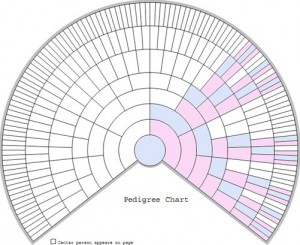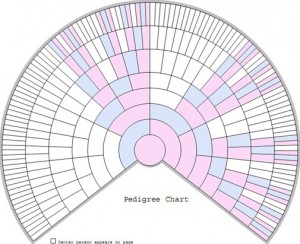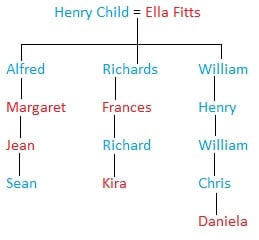In my recent lectures on DNA, I have discussed the nature of X chromosome inheritance. Owing to the fact that males inherit Y chromosomes from their fathers (who received it only from their fathers, etc.), it’s a very specific gender-linked pattern of inheritance. The same is not true for the X chromosome. (Mitochondrial DNA, which is inherited female-to-female, is a different part of our DNA, and not the same as the X chromosome.)
As a male, my single X chromosome is derived from my mother in some combination of the X chromosomes of her parents. My daughter, however, will have two X chromosomes: one that combines attributes of her two maternal grandparents, the other which is exactly the same as my X chromosome, inherited from my mother. The whole nature of the way we inherit our X chromosomes is different for men and women, illustrated in the charts above and at right (borrowed from this blog), and always follows the same formula: “two men in a row, the X is no mo’.”
23andme allows you to see if you and another genetic relative share your X chromosome, and the results follow the pattern shown above. See my chart (below, left) to describe the kinships of the five people[1] covered in this example (as this relates to gender inheritance, men are in blue and women are in red).
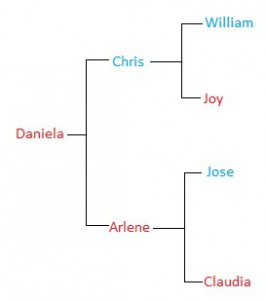 You can see that of Daniela’s two X chromosomes, one is exactly the same as mine and her paternal grandmother, Joy. The other is a combination of her two maternal grandparents, Jose and Claudia. Daniela’s paternal grandfather William has none of his X chromosome in common with Daniela, because two men in a row, the X is no mo’.
You can see that of Daniela’s two X chromosomes, one is exactly the same as mine and her paternal grandmother, Joy. The other is a combination of her two maternal grandparents, Jose and Claudia. Daniela’s paternal grandfather William has none of his X chromosome in common with Daniela, because two men in a row, the X is no mo’.

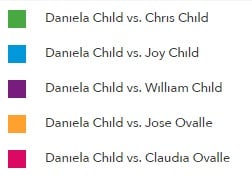 You can also use this formula if you have relatively close cousins (say first to third cousins) who are not known to you, perhaps through an adoption or another “non-paternity event.” If they share part of the X, this can indicate where the likely common ancestors could or could not be, and the same can be determined if none of the X chromosome is shared. In the example below, my “Child” third cousins have also participated in 23andme. While we all share DNA in common, how our X chromosome compares is shown below.
You can also use this formula if you have relatively close cousins (say first to third cousins) who are not known to you, perhaps through an adoption or another “non-paternity event.” If they share part of the X, this can indicate where the likely common ancestors could or could not be, and the same can be determined if none of the X chromosome is shared. In the example below, my “Child” third cousins have also participated in 23andme. While we all share DNA in common, how our X chromosome compares is shown below.
Kira only has some of her X chromosome shared with Sean, as the way they relate is always through two females or one male and then a female. My father, my daughter, and I do not share any of her X chromosome, as our line goes from William to his son Henry, and, thus, two men in a row, the X is no mo’. Also, as this is the only way Kira and Sean are related, we know that this shared X chromosome is part of the X chromosome from our great-great-grandmother, Ella (Fitts) Child.
![]()
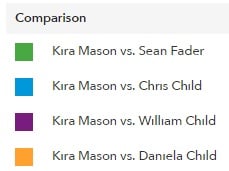 So, when taking autosomal tests and you see an unfamiliar close cousin with some X chromosome in common (or none), it is not completely useless to try figuring out your kinship: just remember, two men in a row, the X is no mo’.
So, when taking autosomal tests and you see an unfamiliar close cousin with some X chromosome in common (or none), it is not completely useless to try figuring out your kinship: just remember, two men in a row, the X is no mo’.
Note
[1] 23andMe only allows you to compare DNA with five people.
Share this:
About Christopher C. Child
Chris Child has worked for various departments at NEHGS since 1997 and became a full-time employee in July 2003. He has been a member of NEHGS since the age of eleven. He has written several articles in American Ancestors, The New England Historical and Genealogical Register, and The Mayflower Descendant. He is the co-editor of The Ancestry of Catherine Middleton (NEHGS, 2011), co-author of The Descendants of Judge John Lowell of Newburyport, Massachusetts (Newbury Street Press, 2011) and Ancestors and Descendants of George Rufus and Alice Nelson Pratt (Newbury Street Press, 2013), and author of The Nelson Family of Rowley, Massachusetts (Newbury Street Press, 2014). Chris holds a B.A. in history from Drew University in Madison, New Jersey.View all posts by Christopher C. Child →
